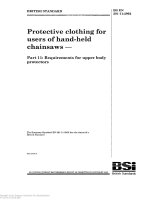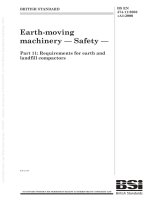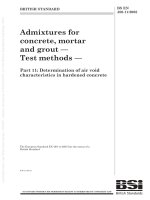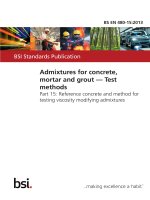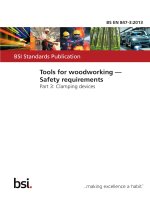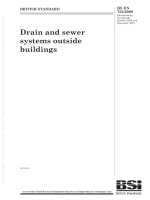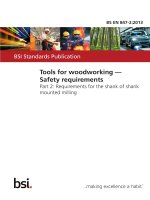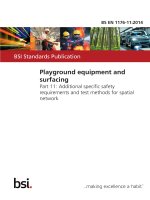Bsi bs en 61189 11 2013
Bạn đang xem bản rút gọn của tài liệu. Xem và tải ngay bản đầy đủ của tài liệu tại đây (3.63 MB, 20 trang )
BS EN 61189-11:2013
BSI Standards Publication
Test methods for
electrical materials, printed
boards and other interconnection
structures and assemblies
Part 11: Measurement of melting temperature
or melting temperature ranges of solder alloys
BRITISH STANDARD
BS EN 61189-11:2013
National foreword
This British Standard is the UK implementation of EN 61189-11:2013. It is
identical to IEC 61189-11:2013.
The UK participation in its preparation was entrusted to Technical Committee EPL/501, Electronic assembly technology & Printed Electronics.
A list of organizations represented on this committee can be obtained on
request to its secretary.
This publication does not purport to include all the necessary provisions of
a contract. Users are responsible for its correct application.
© The British Standards Institution 2013.
Published by BSI Standards Limited 2013
ISBN 978 0 580 68869 0
ICS 31.180
Compliance with a British Standard cannot confer immunity from
legal obligations.
This British Standard was published under the authority of the
Standards Policy and Strategy Committee on 31 July 2013.
Amendments/corrigenda issued since publication
Date
Text affected
BS EN 61189-11:2013
EN 61189-11
EUROPEAN STANDARD
NORME EUROPÉENNE
EUROPÄISCHE NORM
June 2013
ICS 31.180
English version
Test methods for electrical materials, printed boards and other
interconnection structures and assemblies Part 11: Measurement of melting temperature or melting temperature
ranges of solder alloys
(IEC 61189-11:2013)
Méthodes d'essai pour les matériaux
électriques, les cartes imprimées et autres
structures d'interconnexion et ensembles Partie 11: Mesure de la température de
fusion ou des plages de températures de
fusion des alliages à braser
(CEI 61189-11:2013)
Prüfverfahren für Elektromaterialien,
Leiterplatten und andere
Verbindungsstrukturen und Baugruppen Teil 11: Messung der Schmelztemperatur
und Schmelztemperaturbereiche von
Lotlegierungen
(IEC 61189-11:2013)
This European Standard was approved by CENELEC on 2013-06-11. CENELEC members are bound to comply
with the CEN/CENELEC Internal Regulations which stipulate the conditions for giving this European Standard
the status of a national standard without any alteration.
Up-to-date lists and bibliographical references concerning such national standards may be obtained on
application to the CEN-CENELEC Management Centre or to any CENELEC member.
This European Standard exists in three official versions (English, French, German). A version in any other
language made by translation under the responsibility of a CENELEC member into its own language and notified
to the CEN-CENELEC Management Centre has the same status as the official versions.
CENELEC members are the national electrotechnical committees of Austria, Belgium, Bulgaria, Croatia, Cyprus,
the Czech Republic, Denmark, Estonia, Finland, Former Yugoslav Republic of Macedonia, France, Germany,
Greece, Hungary, Iceland, Ireland, Italy, Latvia, Lithuania, Luxembourg, Malta, the Netherlands, Norway, Poland,
Portugal, Romania, Slovakia, Slovenia, Spain, Sweden, Switzerland, Turkey and the United Kingdom.
CENELEC
European Committee for Electrotechnical Standardization
Comité Européen de Normalisation Electrotechnique
Europäisches Komitee für Elektrotechnische Normung
Management Centre: Avenue Marnix 17, B - 1000 Brussels
© 2013 CENELEC -
All rights of exploitation in any form and by any means reserved worldwide for CENELEC members.
Ref. No. EN 61189-11:2013 E
BS EN 61189-11:2013
EN 61189-11:2013
-2-
Foreword
The text of document 91/1086/FDIS, future edition 1 of IEC 61189-11, prepared by IEC TC 91
"Electronics assembly technology" was submitted to the IEC-CENELEC parallel vote and approved by
CENELEC as EN 61189-11:2013.
The following dates are fixed:
•
•
latest date by which the document has
to be implemented at national level by
publication of an identical national
standard or by endorsement
latest date by which the national
standards conflicting with the
document have to be withdrawn
(dop)
2014-03-11
(dow)
2016-06-11
Attention is drawn to the possibility that some of the elements of this document may be the subject of
patent rights. CENELEC [and/or CEN] shall not be held responsible for identifying any or all such patent
rights.
Endorsement notice
The text of the International Standard IEC 61189-11:2013 was approved by CENELEC as a European
Standard without any modification.
In the official version, for Bibliography, the following note has to be added for the standard indicated:
IEC 61189-1
NOTE Harmonized as EN 61189-1.
-3-
BS EN 61189-11:2013
EN 61189-11:2013
Annex ZA
(normative)
Normative references to international publications
with their corresponding European publications
The following documents, in whole or in part, are normatively referenced in this document and are
indispensable for its application. For dated references, only the edition cited applies. For undated
references, the latest edition of the referenced document (including any amendments) applies.
NOTE When an international publication has been modified by common modifications, indicated by (mod), the relevant EN/HD
applies.
Publication
Year
Title
EN/HD
Year
IEC 60194
-
Printed board design, manufacture and
assembly - Terms and definitions
EN 60194
-
IEC 61189-3
-
Test methods for electrical materials, printed EN 61189-3
boards and other interconnection structures
and assemblies Part 3: Test methods for interconnection
structures (printed boards)
-
IEC 61190-1-3
-
Attachment materials for electronic assembly - EN 61190-1-3
Part 1-3: Requirements for electronic grade
solder alloys and fluxed and non-fluxed solid
solders for electronic soldering applications
-
ISO 9453
-
Soft solder alloys - Chemical compositions
and forms
EN ISO 9453
-
ISO 11357-1
-
Plastics - Differential scanning calorimetry
(DSC) Part 1: General principles
EN ISO 11357-1
-
–2–
BS EN 61189-11:2013
61189-11 © IEC:2013
CONTENTS
1
Scope ............................................................................................................................... 5
2
Normative references ....................................................................................................... 5
3
Terms and definitions ....................................................................................................... 5
4
Summary of measuring methods ....................................................................................... 6
5
Test equipment ................................................................................................................. 6
5.1
6
Method A:DSC ........................................................................................................ 6
5.1.1 DSC ............................................................................................................ 6
5.1.2 Balance ....................................................................................................... 6
5.1.3 Pans ............................................................................................................ 6
5.1.4 Inert gas ...................................................................................................... 6
5.1.5 Alumina powder ........................................................................................... 6
5.2 Method B:Cooling curve of molten solder ................................................................ 7
5.2.1 Electric furnace ........................................................................................... 7
5.2.2 Thermocouple.............................................................................................. 7
5.2.3 Measuring instrument .................................................................................. 7
5.2.4 Recorder ..................................................................................................... 7
5.2.5 Container..................................................................................................... 7
Calibration of the temperature .......................................................................................... 7
7
Procedure for the measuring method ................................................................................ 7
7.1
Method A: DSC ....................................................................................................... 7
7.1.1 Test condition .............................................................................................. 7
7.1.2 Procedure for measuring the DSC curve ...................................................... 8
7.2 Method B: Cooling curve of molten solder ............................................................. 10
7.2.1 Test condition ............................................................................................ 10
7.2.2 Procedure for measuring the cooling curve of molten solder .......................... 10
Annex A (normative) Test report on melting temperatures of solder alloys ........................... 12
Annex B (informative) Examples of test result (Method A) .................................................... 13
Annex C (informative) Example of test result (Method B) ..................................................... 14
Bibliography .......................................................................................................................... 15
Figure 1 – Determination of solidus temperature ..................................................................... 8
Figure 2 – Determination of temperature of melting ends ........................................................ 9
Figure 3 – Determination of liquidus temperature .................................................................. 10
Figure 4 – Cooling curves of molten solder ........................................................................... 11
Figure B.1 – Example of test result (Method A: Sn96,5Ag3Cu,5 alloy) .................................. 13
Figure B.2 – Example of test result (Method A: Sn95,8Ag3,5Cu,7 alloy)................................ 13
Figure C.1 – Example of test result (Method B: Sn96,5Ag3Cu,5 alloy) .................................. 14
Figure C.2 – Example of test result (Method B: Sn95,8Ag3,5Cu,7 alloy) ............................... 14
Table 1 – Metal list for calibration ........................................................................................... 7
Table A.1 – Report form ........................................................................................................ 12
BS EN 61189-11:2013
61189-11 © IEC:2013
–5–
TEST METHODS FOR ELECTRICAL MATERIALS,
PRINTED BOARDS AND OTHER INTERCONNECTION STRUCTURES
AND ASSEMBLIES –
Part 11: Measurement of melting temperature or
melting temperature ranges of solder alloys
1
Scope
This part of IEC 61189 describes the measurement method of melting ranges of solder alloys
that are mainly used for wiring of electrical equipment, for electrical and communication
equipment, and for other apparatus, as well as for connecting components.
2
Normative references
The following documents, in whole or in part, are normatively referenced in this document and
are indispensable for its application. For dated references, only the edition cited applies. For
undated references, the latest edition of the referenced document (including any
amendments) applies.
IEC 60194,— Printed board design, manufacture and assembly – Terms and definitions 1
IEC 61189-3, Test methods for electrical materials, printed boards and other interconnection
structures and assemblies – Part 3: Test methods for interconnection structures (printed
boards)
IEC 61190-1-3, Attachment materials for electronic assembly – Part 1-3: Requirements for
electronic grade solder alloys and fluxed and non-fluxed solid solders for electronic soldering
applications
ISO 9453, Soft solder alloys – Chemical compositions and forms
ISO 11357-1, Plastics – Differential scanning calorimetry (DSC) – Part 1: General principles
3
Terms and definitions
For the purposes of this document the terms and definitions of IEC 60194, IEC 61189-3,
IEC 61190-1-3, ISO 9453 and ISO 11357-1, as well as the following apply.
3.1
melting temperature ranges
total range of solidus and liquidus temperature of solder alloys
3.2
solidus temperature
temperature when solder alloys start to melt measured by DSC (method A)
———————
1
Sixth edition to be published.
–6–
BS EN 61189-11:2013
61189-11 © IEC:2013
3.3
solidus temperature
temperature when solidification of solder alloys ends measured by the cooling curve of molten
solder (method B)
3.4
liquidus temperature
temperature when melting ends measured for various heating temperature levels by DSC
(method A)
3.5
liquidus temperature
solidification temperature measured by the cooling curve of molten solder (method B)
3.6
DSC curve
curve measured by differential scanning calorimetry (DSC)
4
Summary of measuring methods
The melting temperature range of solder alloys is measured by using the following methods.
Method A:
Differential scanning calorimetry (DSC).
Method B:
Cooling curve of molten solder.
Test report shall be made according to Annex A.
5
Test equipment
5.1
5.1.1
Method A:
DSC
DSC
See ISO 11357-1.
5.1.2
Balance
The balance shall have a resolution of 0,1 mg or better.
5.1.3
Pans
Pans shall be constructed of a material with a high heat transfer rate and which is not
corroded by the samples. Usually, aluminium is used.
5.1.4
Inert gas
Inert gas (example N2 or Ar: of a purity higher than 99,9 %) should be used to avoid the
sample oxidation.
5.1.5
Alumina powder
Alumina powder should be used as a reference material. It is stable for the temperature range
of the measurement. See ISO 11357-1.
BS EN 61189-11:2013
61189-11 © IEC:2013
5.2
–7–
Method B: Cooling curve of molten solder
5.2.1
Electric furnace
It shall be capable of heating its content to a temperature of 400 °C or higher and provide
good heat insulation.
5.2.2
Thermocouple
A thermocouple that is suitable for the temperature being used, shall be selected. The
compensating lead used shall be suitable for the thermocouple being used.
5.2.3
Measuring instrument
The heat flow measuring instrument shall be capable of measurements of one second
intervals or less.
5.2.4
Recorder
The recorder shall be capable of recording a cooling curve and reading in 0,1 °C units.
5.2.5
Container
The graphite or ceramic crucible shall be used.
6
Calibration of the temperature
Temperature calibration shall be conducted using the pure materials listed in Table 1, whose
purity shall be 99,99 % or higher. The melting points of two or more pure materials that are
close to the temperature to be measured, shall be measured under the same conditions as
those applied to the sample, and a compensation formula with a linear function shall be
determined for the temperature correction from the obtained measurements and the melting
temperatures given in Table 1.
Table 1 – Metal list for calibration
7
Metal
Melting temperature
°C
In (indium)
156,6
Sn (tin)
231,9
Pb (lead)
327,4
Procedure for the measuring method
7.1
Method A: DSC
7.1.1
7.1.1.1
Test condition
Sample mass
The sample mass shall be from 5 mg to 50 mg.
7.1.1.2
Inert gas flow
Inert gas shall be used. Gas flow rate shall be from 10 ml/min to 50 ml/min.
BS EN 61189-11:2013
61189-11 © IEC:2013
–8–
7.1.1.3
Heating rate
Heating rate shall be from 0,5 °C/min to 10 °C/min. Recommended heating rate are 0,5, 1, 2,
5 and 10 °C/min.
7.1.2
7.1.2.1
Procedure for measuring the DSC curve
Instructions
Carry out the measuring DSC curve as follows.
a) The sample is placed in the centre part of pans, and the cap of the pans is put and
clamped.
b) The pan containing the sample is placed on to the pan holder, and the pan with alumina
powder is placed on the other pan holder.
c) Flow the inert gas (example N2 or Ar) until the measurement ends.
d) Carry out the measuring DSC curve with a heating rate of 0,5 °C/min up to a temperature
about 30 °C higher than the heat flow peak.
Repeat procedures a) through d) using a new sample, except heating rate of 1, 2, 5 and
10 °C/min.
7.1.2.2
Solidus temperature
The data of a heating rate of 2 °C/min are used. A typical DSC curve is shown in Figure 1. T1
or T2 represent the solidus temperature.
a) If melting occurs abruptly, then the temperature when melting starts shall be the
temperature T1 at the intersection of the extrapolation of the low-temperature side
baseline towards the high-temperature side and the tangent drawn from the lowtemperature side endothermic peak at the point with the steepest slope, as shown in
Figure 1a. In this case, correct the temperature, using T1 of the pure materials.
b) If melting occurs gradually, then determine temperature T2 at the point at which the curve
starts to leave the baseline, as shown in Figure 1b. In this case, correct the temperature,
using T2 of the pure materials. Repeat the measurement several times and then determine
the average.
T2
Heat flow
Heat flow
T1
Temperature (°C)
Temperature (°C)
IEC 1070/13
Figure 1a – Abruptly melting alloy
IEC 1071/13
Figure 1b – Gradually melting alloy
Figure 1 – Determination of solidus temperature
BS EN 61189-11:2013
61189-11 © IEC:2013
7.1.2.3
–9–
Liquidus temperature
The data of a heating rate of 0,2, 0,5, 1, 2, 5 and 10 °C/min are used. A typical DSC curve is
shown in Figure 2. T3 or T4 indicate the temperature where melting ends.
a) If melting occurs with a single peak,
temperature T3 at the intersection of
baseline towards the low-temperature
temperature side endothermic peak at
Figure 2a.
the temperature of melting ends shall be the
the extrapolation of the high-temperature side
side and the tangent drawn from the highthe point with the steepest slope, as shown in
b) If melting occurs with double or more peaks, the temperature where the melting ends shall
be the temperature T4 at the intersection of the extrapolation of the high-temperature side
baseline towards the low-temperature side and the tangent drawn from the most highesttemperature side endothermic peak at the point with the steepest slope, as shown in
Figure 2b.
Heat flow
Heat flow
T3
Temperature (°C)
Temperature (°C)
IEC 1072/13
Figure 2a – Single melting peak
IEC 1073/13
Figure 2b – Double or more melting peaks
Figure 2 – Determination of temperature of melting ends
c) The extrapolated end temperature of endothermic peak is a linear function of the square
root of the heating rate. Therefore, the point of interception on a temperature axis of the
linear function is assumed to be the liquidus temperature, as shown in Figure 3.
NOTE
Examples of the test results are shown in Annex B.
BS EN 61189-11:2013
61189-11 © IEC:2013
Extrapolated end temperature (°C)
– 10 –
Liquidus temperature
0,5
Square root of heating rate (°C
–0,5
× min
)
IEC 1074/13
Figure 3 – Determination of liquidus temperature
7.2
Method B: Cooling curve of molten solder
7.2.1
7.2.1.1
Test condition
Sample mass
The sample mass shall be 500 g or more.
7.2.1.2
Sample melting
Place the sample in the container and then heat it in the electric furnace until it melts.
7.2.1.3
Thermocouple installation
Position the temperature-measuring junction of the thermocouple in the centre of the molten
solder.
7.2.1.4
Reference junction
The reference junction shall be of the cryoscopic, thermoelectric cooling, or compensating
type.
7.2.2
7.2.2.1
Procedure for measuring the cooling curve of molten solder
Instructions
Melt the entire sample in the crucible, then turn off the power to the electric furnace and
measure the temperature as the sample cools down.
Typical cooling curves of molten solder are shown in Figure 4.
7.2.2.2
Solidus temperature
The solidus temperature shall be determined from the parallel portion, (T6, as shown in
Figure 4b). If undercooling occurs, as shown in Figure 4c, then the temperature T7 at the
intersection of the extrapolation of the parallel portion toward the short-time side and the
cooling curve shall be assumed to be the solidus temperature.
BS EN 61189-11:2013
61189-11 © IEC:2013
7.2.2.3
– 11 –
Liquidus temperature
The liquidus temperature shall be determined from the inflection point (T5) of the cooling
curve (time-temperature curve), as shown in Figure 4a. If two or more inflection points or
parallel portions appear, then the first one shall be used to determine the liquidus temperature.
T5
Time
Temperature (°C)
Temperature (°C)
Temperature (°C)
In some alloys, for example Sn95,5Ag3Cu,5 and Sn95,8Ag3,5Cu,7, liquidus temperature may
not be measured. Annex C shows such examples of cooling curve.
T6
T7
Time
Time
IEC 1075/13
Figure 4a – Inflection
point appears
IEC 1076/13
Figure 4b – Parallel
portion appears
IEC 1077/13
Figure 4c – Undercooling
occurs
Figure 4 – Cooling curves of molten solder
– 12 –
BS EN 61189-11:2013
61189-11 © IEC:2013
Annex A
(normative)
Test report on melting temperatures of solder alloys
Enter the appropriate information in top portion of this report and complete it by entering the
test results. Add the measurements, values, pictures, and so on, as an attachment to this
report, see Table A.1.
Table A.1 – Report form
Date of measurement
Measuring equipment
Sample name
Sample size
Inert gas
Inert gas flow rate
Heating rate
Solidus temperature
Liquidus temperature
BS EN 61189-11:2013
61189-11 © IEC:2013
– 13 –
Annex B
(informative)
Examples of test result (Method A)
Figure B.1 and Figure B.2 show examples of test results of liquidus temperature using
method A.
234
Sn96,5Ag3Cu,5
Extrapolated end temperature (°C)
232
230
228
226
224
222
220
218
216
0
1
2
0,5
Square root of heating rate (°C
3
–0,5
× min
)
IEC 1078/13
Figure B.1 – Example of test result (Method A: Sn96,5Ag3Cu,5 alloy)
234
Sn95,8Ag3,5Cu,7
Extrapolated end temperature (°C)
232
230
228
226
224
222
220
218
216
0
1
2
0,5
Square root of heating rate (°C
3
–0,5
× min
)
IEC 1079/13
Figure B.2 – Example of test result (Method A: Sn95,8Ag3,5Cu,7 alloy)
BS EN 61189-11:2013
61189-11 © IEC:2013
– 14 –
Annex C
(informative)
Example of test result (Method B)
Figure C.1 and Figure C.2 show examples of test results of liquidus temperature using the
cooling curve method where the solidification start could not be detected.
400
Temperature (°C)
350
No detection that the solidification starts
300
217 °C
250
200
150
0
1 000
2 000
3 000
4 000
5 000
6 000
7 000
Time (s)
8 000
IEC 1080/13
Figure C.1 – Example of test result (Method B: Sn96,5Ag3Cu,5 alloy)
400
Temperature (°C)
350
No detection that the solidification starts
300
250
217 °C
200
150
0
1 000
2 000
3 000
4 000
Time (s)
5 000
6 000
7 000
8 000
IEC 1081/13
Figure C.2 – Example of test result (Method B: Sn95,8Ag3,5Cu,7 alloy)
BS EN 61189-11:2013
61189-11 © IEC:2013
– 15 –
Bibliography
IEC 61189-1, Test methods for electrical materials, interconnection structures and assemblies
– Part 1: General test methods and methodology
_____________
This page deliberately left blank
This page deliberately left blank
NO COPYING WITHOUT BSI PERMISSION EXCEPT AS PERMITTED BY COPYRIGHT LAW
British Standards Institution (BSI)
BSI is the national body responsible for preparing British Standards and other
standards-related publications, information and services.
BSI is incorporated by Royal Charter. British Standards and other standardization
products are published by BSI Standards Limited.
About us
Revisions
We bring together business, industry, government, consumers, innovators
and others to shape their combined experience and expertise into standards
-based solutions.
Our British Standards and other publications are updated by amendment or revision.
The knowledge embodied in our standards has been carefully assembled in
a dependable format and refined through our open consultation process.
Organizations of all sizes and across all sectors choose standards to help
them achieve their goals.
Information on standards
We can provide you with the knowledge that your organization needs
to succeed. Find out more about British Standards by visiting our website at
bsigroup.com/standards or contacting our Customer Services team or
Knowledge Centre.
Buying standards
You can buy and download PDF versions of BSI publications, including British
and adopted European and international standards, through our website at
bsigroup.com/shop, where hard copies can also be purchased.
If you need international and foreign standards from other Standards Development
Organizations, hard copies can be ordered from our Customer Services team.
Subscriptions
Our range of subscription services are designed to make using standards
easier for you. For further information on our subscription products go to
bsigroup.com/subscriptions.
With British Standards Online (BSOL) you’ll have instant access to over 55,000
British and adopted European and international standards from your desktop.
It’s available 24/7 and is refreshed daily so you’ll always be up to date.
You can keep in touch with standards developments and receive substantial
discounts on the purchase price of standards, both in single copy and subscription
format, by becoming a BSI Subscribing Member.
PLUS is an updating service exclusive to BSI Subscribing Members. You will
automatically receive the latest hard copy of your standards when they’re
revised or replaced.
To find out more about becoming a BSI Subscribing Member and the benefits
of membership, please visit bsigroup.com/shop.
With a Multi-User Network Licence (MUNL) you are able to host standards
publications on your intranet. Licences can cover as few or as many users as you
wish. With updates supplied as soon as they’re available, you can be sure your
documentation is current. For further information, email
BSI Group Headquarters
389 Chiswick High Road London W4 4AL UK
We continually improve the quality of our products and services to benefit your
business. If you find an inaccuracy or ambiguity within a British Standard or other
BSI publication please inform the Knowledge Centre.
Copyright
All the data, software and documentation set out in all British Standards and
other BSI publications are the property of and copyrighted by BSI, or some person
or entity that owns copyright in the information used (such as the international
standardization bodies) and has formally licensed such information to BSI for
commercial publication and use. Except as permitted under the Copyright, Designs
and Patents Act 1988 no extract may be reproduced, stored in a retrieval system
or transmitted in any form or by any means – electronic, photocopying, recording
or otherwise – without prior written permission from BSI. Details and advice can
be obtained from the Copyright & Licensing Department.
Useful Contacts:
Customer Services
Tel: +44 845 086 9001
Email (orders):
Email (enquiries):
Subscriptions
Tel: +44 845 086 9001
Email:
Knowledge Centre
Tel: +44 20 8996 7004
Email:
Copyright & Licensing
Tel: +44 20 8996 7070
Email:
